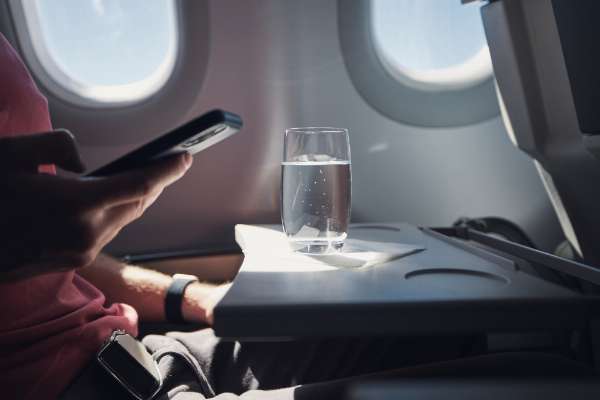In-flight Wi-Fi is now increasingly common, letting passengers stay connected with work or leisure activities while cruising at 35,000 feet. But how exactly does it work? Let’s take a closer look at the technologies and challenges involved in providing in-flight Wi-Fi. From satellite connections high above the Earth to ground-based networks, learn how your devices tap into a virtual lifeline and what factors influence the speed and reliability of that connection.
The Technology Behind In-Flight Wi-Fi
Your home internet connection most likely relies on some type of cable or wire. Cable internet, for example, uses the same cable networks that cable TV does. But a moving plane can’t rely on a wired connection. So how does in-flight Wi-Fi work?
In-flight Wi-Fi typically relies on one of two technologies: satellite connections and ground-based wireless networks.
The satellite-based system uses a network of orbiting satellites that communicate directly with aircraft antennas mounted on the plane's exterior. These antennas send and receive data from the satellites, which are linked to ground stations that connect to the broader internet infrastructure. This is simply a version of satellite internet, which is also available to customers on the ground.
Alternatively, some airlines use an air-to-ground (ATG) network, where antennas on the aircraft establish a direct link to cell towers on the ground below. This method functions like a cellular network, allowing data transmission between the aircraft and the ground. This is also similar to a type of internet you could get at home: fixed wireless, which connects a home network to the internet using cell towers. (The fastest and most exciting version of this technology is 5G home internet.) The airline version of this connection isn’t quite as “fixed,” of course, but it works in essentially the same way.
Regardless of the method used, the rest of the setup is pretty much what you’d have at home. A modem interprets the signals from the internet connection, and a router creates the Wi-Fi network.
Why Can’t I Use Certain Websites or Apps on In-Flight Wi-Fi?
Since in-flight Wi-Fi works a lot like satellite or fixed wireless internet connection types on the ground, we’d expect it to work with all of the same apps and websites that we can use on the ground. Yet, as frequent fliers well know, many airlines forbid the use of certain apps and websites, such as Zoom. Why don’t these sites and apps work with in-flight Wi-Fi?
The simple answer is they could work. There’s nothing about the technology that prevents us from accessing the internet as usual. What’s happening here is that airlines are setting up certain limitations on their networks on purpose. Why do they do that? There are a few reasons. Some are good, some are bad.
The first good reason is traffic — not in the air, but online. With all passengers sharing the same network, there’s a lot of data to pass back and forth. Your internet wouldn’t be too quick if you invited 400 friends over to watch Netflix at once! The same problem exists on a packed 747, and it's worsened by the fact that wireless connection types like satellite aren’t typically as fast as cable or fiber internet. To keep the internet functional for all users, airlines try to limit bandwidth-intense activities like video conferencing.
Of course, passengers aren’t just sharing Wi-Fi — they’re also sharing a cramped space! That’s another reason why certain apps, particularly video conferencing apps, are often blocked on planes.
One less appealing reason for Wi-Fi limitations is that airlines can monetize them. There’s no “net neutrality” in the sky. Airlines are free to set up tiers of paid Wi-Fi service and charge more for the right to visit certain websites or use certain apps.
What Is “Airplane Mode?”
Airplane mode (or “flight mode”) is a setting on any electronic device that prevents it from sending or receiving cellular signals. While your device is in airplane mode, you won’t be able to make calls or send SMS text messages.
You will, however, still be able to use Wi-Fi. Certain text messaging, like WhatsApp or iMessage, apps that work online (not just over cellular connections) will work over this Wi-Fi connection.
Bluetooth connections should also work while in airplane mode. Certain devices will remember if you turn off your Bluetooth while in airplane mode. If you see your Bluetooth is shut off when you turn airplane mode on, that’s probably why. (Airplane mode does not actually require you to shut off Bluetooth devices!)
While you won’t be able to stream any videos online or use the internet, you can still use your phone as long as your activity doesn’t require a cellular connection. Playing mobile games offline or listening to downloaded music are things you can do on your flight without using the internet, of course. And if you have access to in-flight Wi-Fi, you can use all sorts of internet-connected apps while in airplane mode, including some messaging apps.
If you’re thinking limiting internet on flights is unnecessary, think again. Using cellular networks can interfere with communication systems that the airline may need to guide the plane. Airplane Mode will disable devices from receiving cellular connections, preventing any disruption during the flight.



